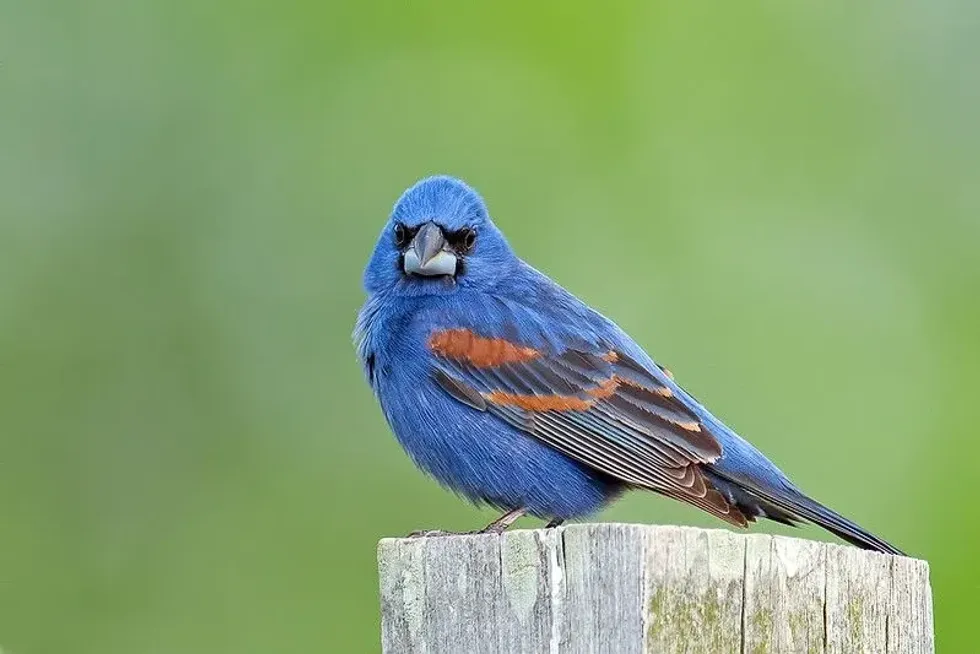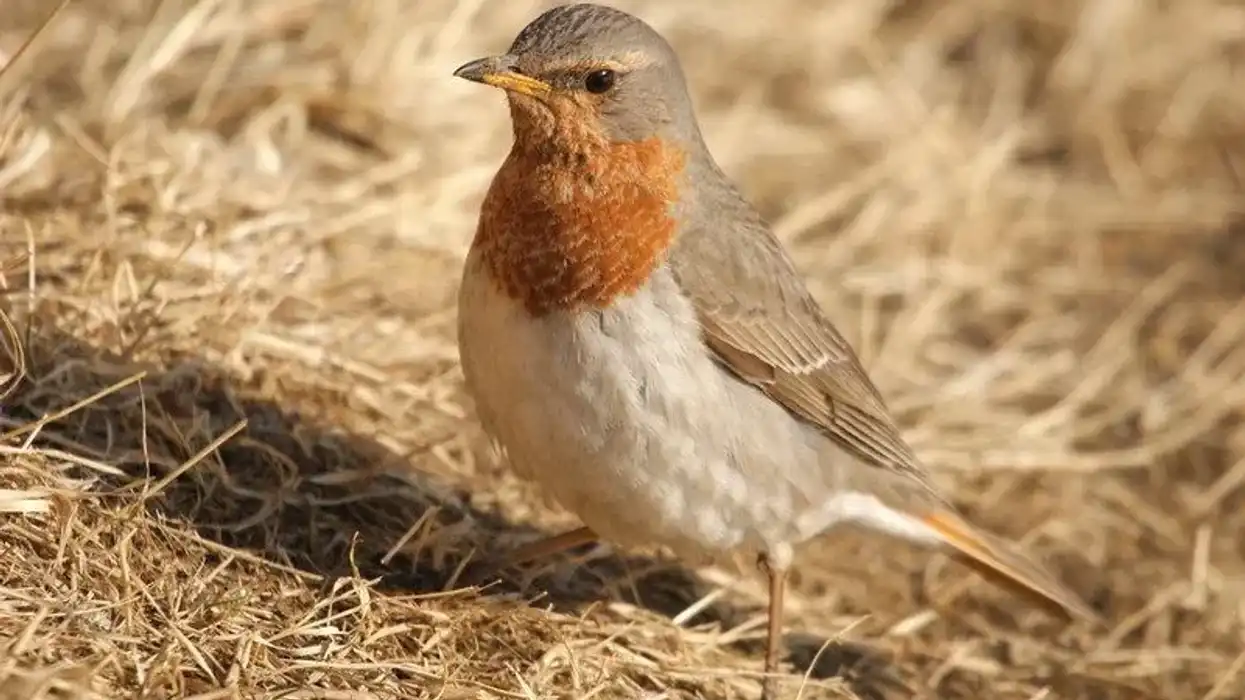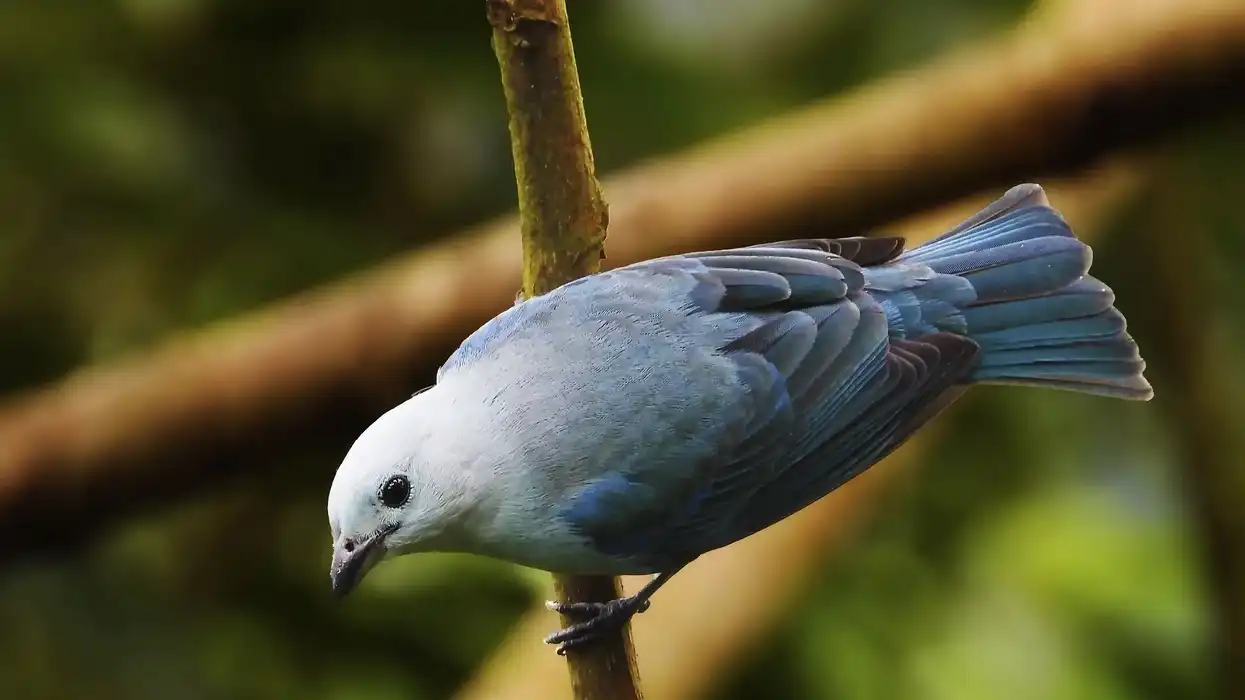The blue grosbeak Passerina caerulea is a beautiful and small bird native to North American regions as well as southern parts of America and parts of Central America like northern Mexico. It's a bird that is closely associated with old fields and woodland edges.
The blue grosbeak was named for its large beak and the fact that they are blue in plumage. The females of the species are different in color. The blue grosbeak range in weight from 0.9-1.1 oz (or 26-31.5 g).
It's recognized for its loud voice. They are known to give low 'buzzy bsst' calls and metallic chinks when disturbed. The blue grosbeak song is unique and beautiful to hear.
The blue grosbeaks live in low densities. The breeding range expanded northward in the late nineteenth century.
The indigo bunting, lazuli bunting among others are species often mistaken for each other although they have differences from each other. Blue grosbeak vs indigo bunting is similar in appearance however while the blue grosbeak has prominent rusty wing bars the indigo bunting is relatively smaller in size and has a smaller beak size too.
They are unique birds and live in different habitats which is another way to understand the difference between indigo bunting vs blue grosbeak. The indigo bunting resides in deciduous forests while the blue grosbeak resides in brush and trees.
Apart from the listed species, there is the blue-black grosbeak, juvenile blue grosbeak, and the immature blue grosbeak.
Read on to learn about these colorful North American birds. If you like this article then visit Caroline parakeet and laughing kookaburra facts too.
Blue Grosbeak Interesting Facts
What type of animal is a blue grosbeak?
The blue grosbeak bird is a type of bird and belongs to the kingdom Animalia. The blue grosbeak sounds loud when in danger but is only moderately noisy otherwise.
What class of animal does a blue grosbeak belong to?
Blue grosbeak birds classify under the head Aves and are a type of bird that belongs to the Cardinalidae family.
How many blue grosbeaks are there in the world?
The exact number of the species is undetermined however they are identified as a bird in the Least Concern conservation category.
Where does a blue grosbeak live?
Blue grosbeaks live in woodlands. They breed in areas covered in a mix of grass and shrubs with a few taller trees. They can be attracted into houses by offering them berries and water to drink in selected areas.
What is a blue grosbeak's habitat?
The blue grosbeak habitat is in open areas near shrubs and trees. They have begun to grow in woodlands. These birds breed in a mix of regions. In arid regions, they utilize shrubby growths along watercourses.
Who do blue grosbeaks live with?
Although they reside in open areas they are surrounded by their own species as well as other insects, birds, and animals in the forests some of whom they prey on and some of whom these birds are prey to.
How long does a blue grosbeak live?
The blue grosbeak lives approximately six years. The longest blue grosbeak that lived has been recorded at seven years and two months old.
How do they reproduce?
These birds are monogamous and raise two broods. The blue grosbeak's nest is concealed in weeds, shrubs, or a small tree. The male sings to defend this nest.
Once the nest is ready and post-mating the blue grosbeak female lays three to four eggs. The eggs are incubated for 11-12 days also known as the nesting period by the female bird and are fed by their mothers when they are in the nest.
When these birds start to fledge the male blue grosbeak bird is responsible for feeding the nestlings when they are 9-10 days old. During this time the female bird prepares another nest for the second clutch. The second brood occurs in the southern part after migration.
What is their conservation status?
Glaucous-blue grosbeak species is a medium-sized bird considered to be a Least Concern species by the International Union For Conservation Of Nature (IUCN). Although they are the least concerned species, their population has been severely affected by urbanization and spring heatwaves.
Blue Grosbeak Fun Facts
What do blue grosbeaks look like?
Male grosbeaks are blue in color while females are a brown shade. Both are equally beautiful. Blue grosbeak wings are set for swift flight with rapid wing beats. Blue grosbeak sound is melodious in nature and the blue grosbeak call is loud in nature. Their eyes are dark brown and their legs are gray.
How cute are they?
These birds are small and extremely cute to look at. The blue grosbeak Passerina caerulea is a bird in the wild that loves to feed on insects and seeds.
Attracting this bird is simple as long as you decide to give it a proper place like a nestbox where they can easily come and feed on berries and also drink water. They are beautiful and sweet creatures.
How do they communicate?
Only male blue grosbeaks know how to sing properly. This song is usually long and lasts for a few seconds. Older species have longer songs than the young ones. They make use of this communication specifically during the mating and breeding season.
How big is a blue grosbeak?
The blue grosbeak is 10-11 in(26-29 cm) tall which is ten times bigger than the smallest bird in the world the bee hummingbird which is 2.4 in (6.1 cm) tall.
How fast can a blue grosbeak fly?
They are seen flying low over the ground and also hover when necessary. They fly low in order to be able to search for prey i.e. insects like snails and beetles. They also fly primarily when they migrate to other regions. They fly at moderate speeds.
How much does a blue grosbeak weigh?
The blue grosbeak is recognized as a bird that exists in North America as well as Central America, like in Northern Mexico, and weighs 0.9-1.1 oz in weight which is approximately 26-31.5 g.
What are their male and female names of the species?
The male and female blue grosbeaks species are not named differently however they can be identified by their distinct appearance and color. This can be compared similarly to the case of peacocks where the male peacock is more colorful than the female counterparts.
This is primarily due to the reason that males use their appearance to attract females and mate. Males usually have to compete with each other in order to be able to increase their chances to mate with females.
What would you call a baby blue grosbeak?
The young blue grosbeaks are referred to as an egg when born and as a nestling when they hatch. The eggs are referred to as eggs until they hatch. Once hatched they are referred to as nestlings until they grow up develop feathers and wings and are ready to fly as an adult bird.
What do they eat?
Blue grosbeaks are native to northern and central America and primarily feed on seeds, berries, and insects including spiders, worms, and ants. They look through agricultural fields as well as pastures to find appropriate food.
This is another reason why farmers install scarecrow's in the field to ensure that birds don't destroy crops specifically seed crops. When feeding young ones the parents remove the head legs and wings of the insects they feed to the nestlings to make digestion easier for the little ones.
How high can they fly?
These birds are usually low-lying birds, in other words, they hardly fly high up. Their wings are prepared for plumage and they fly at moderate speeds. They however can sing in high propensity.
Would they make a good pet?
Keeping them as pets is illegal in most areas however they are captured and kept as pets in homes. It's best to enquire with professionals if you can own them as a pet in the region you live in.
These birds are largely wild birds and it's not right to restrict birds and keep them in cages. It's better to opt for other birds who are more compatible with living with people like parrots.
Did you know...
Predators who eat them include hawks, raptors, snakes, and cats. You might wonder how cats become predators to birds, but nevertheless, it's advised not to keep cats near birds. They are unlikely friends.
Small birds are known to carry diseases however, the blue grosbeaks are not transmitters of any kind of disease.
How did the blue grosbeak get its name?
The blue grosbeak got its name from French "gros bec" which means "big beak". According to genetic evidence, the closest relative bird to these species is the lazuli bunting birds.
How do you attract grosbeaks?
Nest boxes can be installed outside homes with seeds, berries, and water. Seeing this, the birds flying are likely to stop by and pay you a visit.
Keeping these wild and migratory birds as pets is not always allowed in regions hence it's essential to check about the legalities of this.
These unique and beautiful species are a true sight to see. You can also visit birdwatching sites and other parks and reserves where the birds exist if you are in or visiting regions like North and Central America, parts of Mexico, California, and some regions of the United States.
Here at Kidadl, we have carefully created lots of interesting family-friendly animal facts for everyone to discover! Learn more about some other birds including Frigate bird, or golden oriole.
You can even occupy yourself at home by drawing one on our blue grosbeak coloring pages.









